I have drawn the attached funnel plot in ggplot, But I have 2 questions:
- Is there any way to make the coloured green dot bigger (only that one);
- is there any way to colour the upper and lower part of the confidence intervals?

This is what I am able to make so far:

Thank you!
The data set I am working on:
df <-
read.table(text = "
school_id year sdq_emotional
1060 7 4
1060 7 5
1060 7 7
1060 7 6
1060 7 4
1060 7 7
1060 7 8
1115 7 5
1115 7 9
1115 7 3
1136 7 1
1136 7 8
1136 7 5
1136 7 9
1135 7 4
1139 7 7
1139 7 3
2371 7 6
2371 7 3
2372 7 4
2372 7 1
2378 7 6
2378 7 7
2378 7 5", header=TRUE)
My code as follows:
# Format the data
df1 <- plyr::count(df, c('school_id'))
df2 <- merge(df,df1, by= c("school_id"))
df <- df2
M3 <- aggregate(df$sdq_emotional[df$freq > 10], by=list(df$school_id[df$freq > 10]),mean,na.rm=T)
S3 <- aggregate(df$sdq_emotional[df$freq > 10], by=list(df$school_id[df$freq > 10]),nona)
CG_PLOT1 <- merge(M3,S3,by="Group.1")
names(CG_PLOT1) <- c("School","Mean","Size")
LINE3 <- data.frame(M3=rep(mean(df$sdq_emotional,na.rm=T),max(CG_PLOT1$Size)+25),
SD3=rep(sd(df$sdq_emotional,na.rm=T),max(CG_PLOT1$Size)+25),
N3=sqrt(1:(max(CG_PLOT1$Size)+25)))
ID <- 1060
filling3 <- rep("white",nrow(CG_PLOT1))
filling3[CG_PLOT1$School ==ID]<-"green"
# Build the graph
ggplot(data = CG_PLOT1) +
geom_line(data = LINE3, aes(x = 1:(max(CG_PLOT1$Size) + 25),
y = M3 + qnorm(0.975) * SD3 / N3), size = 1, colour = "steelblue2",
linetype = 5) +
geom_line(data = LINE3, aes(x = 1:(max(CG_PLOT1$Size) + 25),
y = M3 - qnorm(0.975) * SD3 / N3), size = 1, colour = "steelblue2",
linetype = 5) +
geom_segment(xend = max(CG_PLOT1$Size)+25,yend=mean(LINE3$M3,na.rm=T)),
aes(x = 1, y = mean(LINE3$M3,na.rm=T), size=1, colour="steelblue2") +
geom_point(data = CG_PLOT1, aes(x = Size, y = Mean), size = 2,
colour = "black", shape = 21,fill = filling3) +
ylim(0, 8)
thank you very much!
